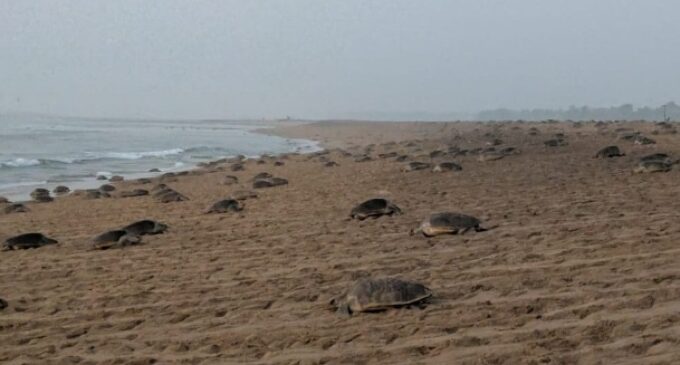Record mass nesting of Olive Ridley Sea Turtles at Rushikulya river mouth

By Prakash Panigrahi
Berhampur (Ganjam, Odisha), Feb. 24: The Rushikulya river mouth, a picturesque coastal stretch along the Bay of Bengal in Odisha’s Ganjam district, has witnessed a spectacular natural phenomenon this season, as record numbers of Olive Ridley sea turtles arrived for mass nesting. This site, along with Odisha’s Gahirmatha beach in Kendrapara district, is globally recognized as one of the most significant rookeries for these endangered marine creatures. Between February 16 and 24, an astounding 6.98 lakh Olive Ridley turtles gathered at Rushikulya, making this year’s nesting event truly historic.
According to Dibya Sankar Behera, the Assistant Conservator of Forests (ACF) at Khallikote, the mass nesting concluded on February 24, with 6,98,718 turtles laying eggs—surpassing last year’s record of 6.37 lakh. In 2023, 6,37,008 turtles nested between February 23 and March 2, while 5.50 lakh turtles laid eggs in 2022.
The success of this year’s nesting season is largely attributed to the exceptional support of the local communities, particularly the fishermen. Traditionally dependent on marine fishing for their livelihoods, they showed remarkable cooperation by voluntarily pausing their fishing activities during the nesting period. Their dedication to safeguarding the turtles’ habitat played a crucial role in ensuring a disturbance-free environment.
Additionally, local non-governmental organisations (NGOs) played a key role in spreading awareness about the importance of protecting these migratory visitors. By engaging with locals and educating them on the ecological significance of the Olive Ridley turtles, the NGOs helped foster a community-wide commitment to conservation.
Experts believe that favorable climatic conditions contributed significantly to the successful nesting season. To enhance protection, the forest department took proactive steps by installing fences along newly identified nesting areas, spanning a 9-kilometer stretch from New Podampeta to Prayagi.
“We set up fencing to safeguard the eggs from natural predators like dogs and jackals. Every measure was taken to protect the eggs and ensure a safe nesting environment,” explained ACF Behera.
The phenomenon of mass nesting by Olive Ridley turtles is known as ‘arribada,’ a Spanish term describing the synchronized nesting of thousands of female turtles. Experts predict that the eggs will hatch after 45 days, at which point the newborn hatchlings will instinctively head towards the sea. This journey, witnessed by many, offers a mesmerizing natural spectacle.
“This year’s unprecedented nesting event at Rushikulya highlights the incredible harmony between nature, local communities, and conservation authorities,” remarked Dr. Prakash Jena, a prominent environmental activist.
Photograph: Olive Ridley turtles nesting at Rushikulya river mouth






